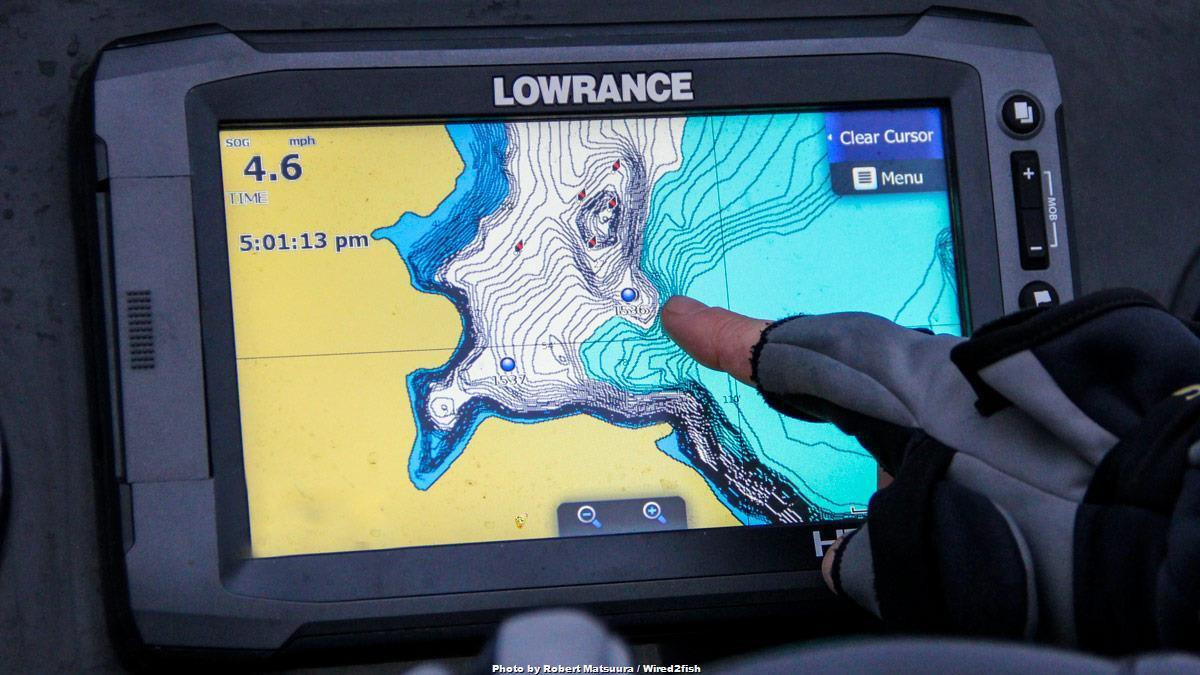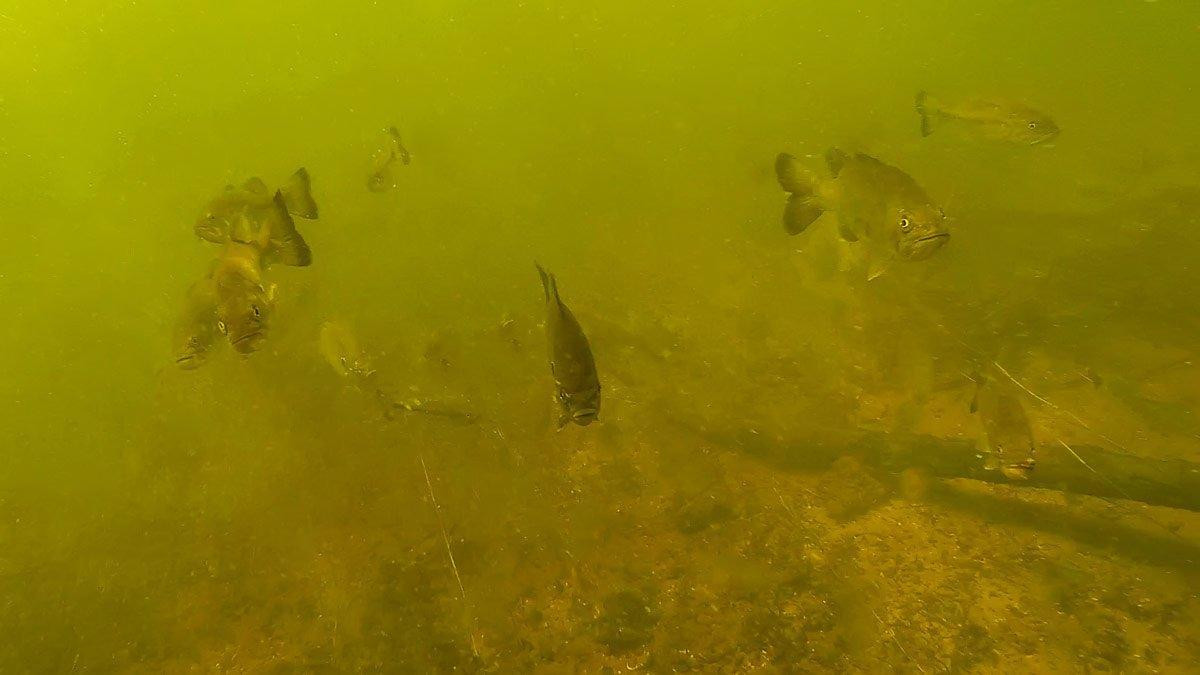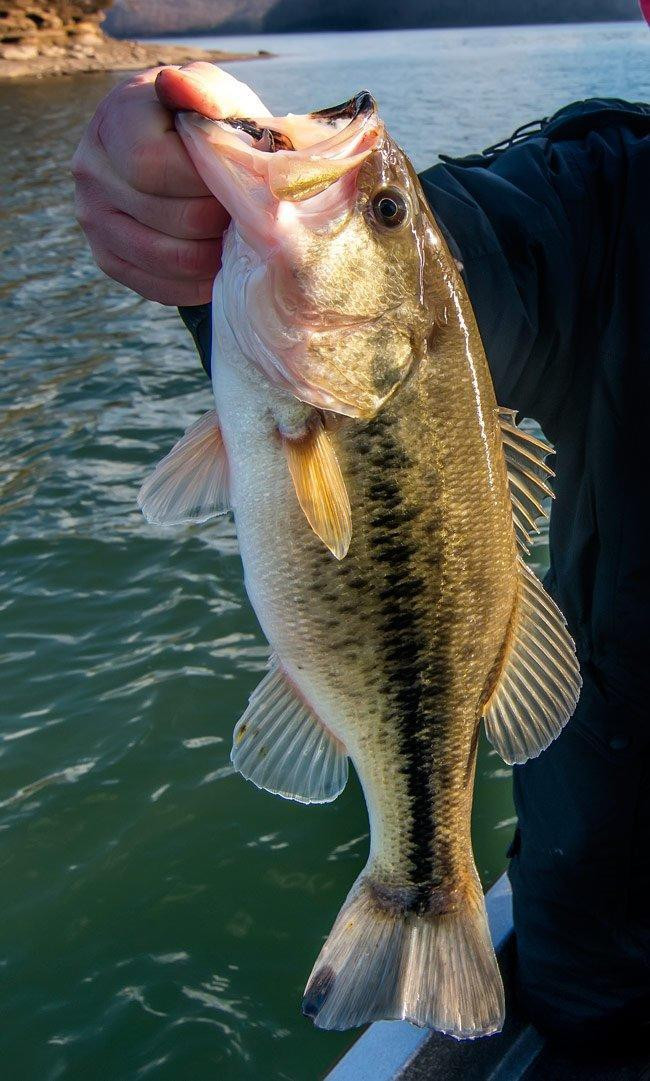In the winter, when water temperatures drop below 60 degrees, bass will migrate towards deep water. Bass are cold blooded which means their body is the same temperature as the water around them. They don’t like changes in temperature, deeper water is warmer and stays at a consistent temperature during the winter.
A lot of anglers store their boat until spring, so lakes experience less boat pressure in the winter. Elite Series pro Josh Bertrand looks forward to this time of year. Some of his most memorable fishing days came all by himself in the dead of winter. It can be tough but when you do find a school of feeding bass you can load the boat fast.
Love your electronics
Electronics become more important this time of year because you will be fishing underwater structure and searching for schooling fish in very small spots. As Bertrand idles out from the launch ramp, he will watch his graph to see which depth the fish are holding. Once he finds that depth, he uses it as a starting point.
Bertrand studies the contour map on his graph and idles in a zig zag pattern over various areas to search for active fish and structure. Active fish will look like snakes or spaghetti noodles on your graph.
“Be Patient,” Bertrand said. “Don’t just stop when you see one fish mark. Look for a big bait ball with fish going into it.”

Know your areas
Bertrand will key on 3 types of areas including the following:
- Deep flats
- Creek channels
- Points
Deep Flats
Bertrand begins his search by probing deep flats. They can be vast ares and that much area to cover can be somewhat intimidating, but if you can locate active feeding fish, it can also be epic. He starts at the depth he found near the ramp that fish showed up on his graph and idles in a zig zag pattern until he finds a closely packed active feeding group of fish.
“Think of the flat as a big dinner plate that fish are pushing all the bait on, and once that happens, it becomes a feeding frenzy.”
In most feeding situations, bass will use structure to ambush bait, but when feeding on a deep flat, they will herd bait around and feed franticly. The best way to catch deep winter bass in this feeding frenzy scenario is with a spoon. Ss the school moves around the flat, he will use a casting spoon to relocate them.

Creek Channels
Bertrand then checks creek channels because bass they are the highways from one winter area to another. He will key in on either bends or structure within the channel like trees and ledges.
“As bass move throughout the creek channel they will stop on unique cover to feed and ambush baitfish,” Bertrand said. “My favorite is standing timber. When you think about a spoon in the trees, it sounds like a disaster. Most of the time, however, I can use the weight of the spoon to free it if it hangs on a branch.”
Points
The final area Bertrand will fish during the winter are points. Points are used as ambush spots and hold fish year around. He will concentrate on points that run near or into the main river channel. On the point he locates a sweet spot like a sharp break, tree, or rock pile. Once he locates the sweet spot he will position the boat in shallow water casting out towards deep water using a jig or dropshot. “Dragging my bait up hill helps me keep constant bottom contact which is key in getting bass to bite”

Keep tackle simple
Bertrand usually sticks with just 4 lures when chasing these deep feeding schools of bass in the winter — three vertical lures and one horizontal lure:
- Jigging Spoon
- Casting Spoon
- Drop-shot plastic
- Football jig
Spoon
When Bertrand locates a school of active feeding fish, a spoon is his favorite way to catch them. “There is not a more effective and faster way to load the boat when you locate feeding fish.” With a half ounce lure and spinning rod he can drop straight down on the fish quickly. He will jig the spoon up and down around 1 to 2 feet, most of the time bass will hit as you let the spoon fall to the bottom.
- Rod: Abu Garcia Veracity 7-foot MH Spinning rod
- Reel: Abu Garcia Revo SX 30
- Line: 8-pound Berkley NanoFil with10-pound Trilene fluoro
- Bait: Chrome 1/2-ounce Strata Spoon
Flutter Spoon
If the spoon bite starts to slow and he doesn’t see as many bass on his graph he fan casts a flutter spoon to relocate the school. He will let the spoon hit the bottom then retrieve the spoon by ripping it about 5 feet off the bottom. Most of the bites will come as the spoon falls back down to the bottom. The flutter spoon is a heavy large bait so it is important to keep constant pressure when reeling in a fish. To help keep the fish stay hooked he adds a extra split ring on the hook.
- Rod: Abu Garcia Veracity 7-foot, 6-inch heavy Casting Rod
- Reel: Abu Garcia Revo SX 7:1
- Line: 20-pound Trilene Fluorocarbon
- Bait: Pro Swimbaits Eye2 Flutter Spoon
Dropshot
Bertrand will use the dropshop on points and creek channels when fishing is tough. He will use a 8 to 10 inch leader which may seem short, but it works a lot better when bass seem more sluggish and are staying near the bottom. Most of the time dead sticking is his favorite way to work a dropshot “I have my most success when doing nothing, literally just a slow drag to the boat.”
- Rod: Abu Garcia Veracity 6-foot, 9-inch ML Spinning rod
- Reel: Abu Garcia Revo SX 20
- Line: 8-pound Berkley Nanofil with a 6-pound Trilene fluoro leader
- Bait: Gamakatsu No. 1 dropshot hook with a Berkley Bottom Hopper
Football Jig
When bass seem to be staying near the bottom he casts a football jig. He will cast and drag the football jig, always staying in contact with the bottom. By using a heavy jig and keeping bottom contact, the jig is a good locator bait. He uses it to find sweet spots and figure out what is on the bottom. “With a heavy jig I can tell whether I am dragging on sand, dirt, or rock.” Most of the time a football jig will catch more quality fish, so after he has a limit this bait is in his hands the rest of the day in a tournament.
- Rod: Abu Garcia Veracity 7-foot, 6-inch MH casting rod
- Reel: Abu Garcia Revo SX 7:1
- Line: 15-pound Trilene PG fluorocarbon
- Bait: 3/4-ounce Pepper Custom football jig with a Berkley Chigger Craw

Remember, it’s winter, and the bite can be tough but that doesn’t mean you can’t also have a very memorable fun day on the water. Be patient and use your graph. It’s more of a search game in the winter. But when you find that one magic spot, it can be epic. Take the time to enjoy the peaceful lake that you’ll probably have all to yourself.












